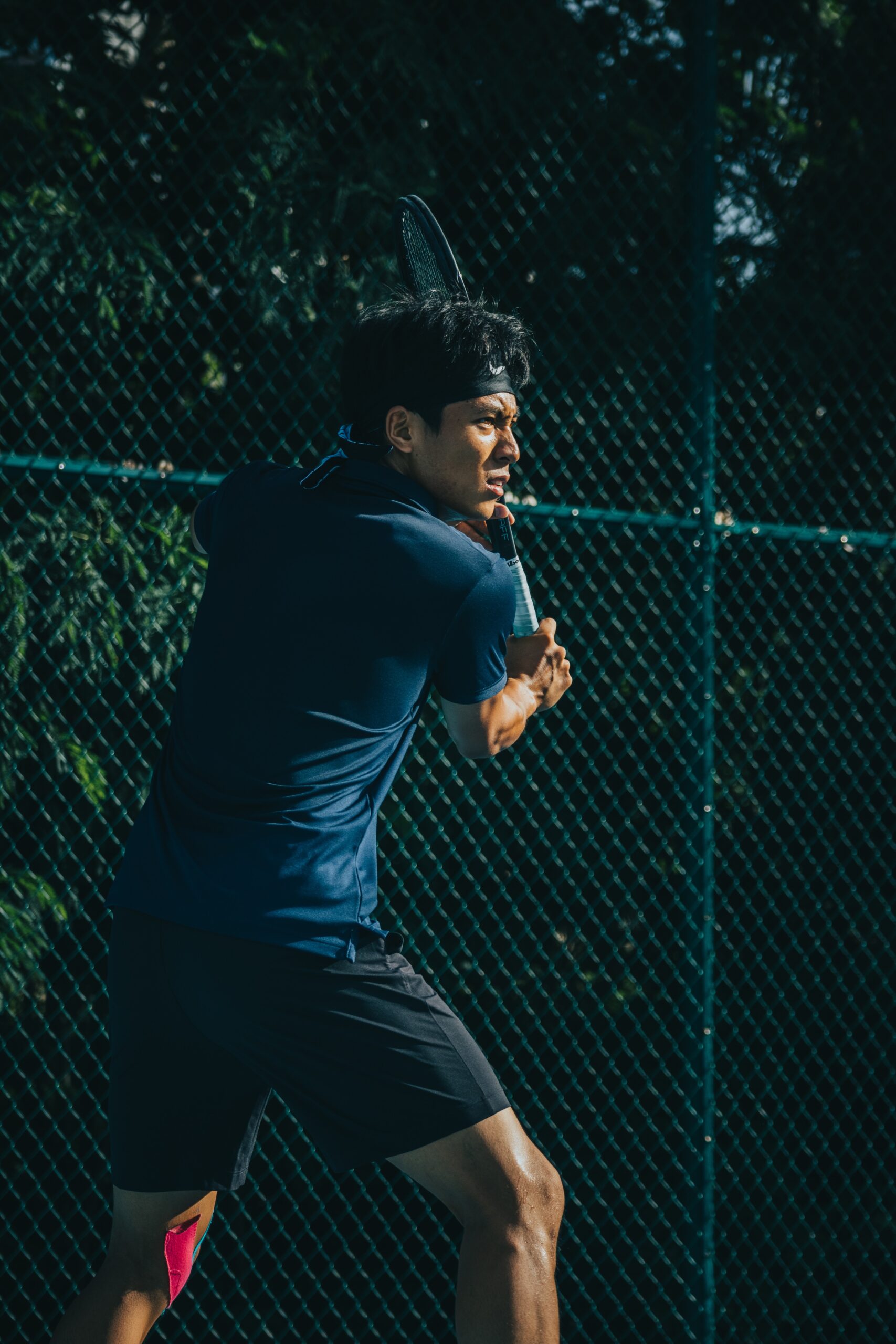If you’ve ever watched a tennis match and wondered about the different strokes players use, specifically the forehand and backhand, you’re not alone. These two shots play a crucial role in a player’s arsenal, but what sets them apart? A forehand in tennis is when a player hits the ball with their dominant hand on the same side as their natural swing, while a backhand is executed with the non-dominant hand on the opposite side. Understanding the nuances of these shots is key to mastering the game of tennis, so let’s explore the differences between a forehand and a backhand, and how they can impact a player’s performance on the court.
Grip
Eastern Grip
The Eastern grip is one of the most commonly used grips in tennis. To achieve the Eastern grip, you place your base knuckle of your index finger on the third bevel of the racket handle. This grip allows for a more stable and controlled forehand stroke. It also provides a good balance between power and control, making it a versatile option for players of all skill levels.
Continental Grip
The Continental grip is another popular grip in tennis, especially for serving and volleying. To use the Continental grip, place your base knuckle of your index finger on the second bevel of the racket handle. This grip allows for maximum wrist mobility, making it ideal for executing different types of spins, such as topspin and slice. It’s also commonly used for the backhand stroke on the non-dominant hand.
Western Grip
The Western grip, also known as the extreme grip, is used primarily for generating maximum topspin. It involves placing the base knuckle of your index finger on the fourth bevel of the racket handle. This grip allows for a more upward swing path, enabling you to brush the ball and create heavy topspin shots. While it can produce powerful shots, the Western grip may require more strength and control.
Stance
Open Stance
The open stance is a footwork technique where your front foot is positioned slightly towards the side of the court. This stance is often used when dealing with faster shots or when you want to have a quicker recovery to the center of the court. It allows for better rotation and weight transfer during the stroke, providing stability and power.
Closed Stance
In contrast to the open stance, the closed stance involves positioning your front foot parallel to the baseline. This stance is commonly used for more controlled shots, such as volleys or defensive plays. It provides a solid foundation and allows for excellent weight transfer, enabling you to maintain balance and generate power from the ground up.
Semi-open Stance
The semi-open stance is a combination of the open and closed stance. It involves positioning your front foot slightly towards the net while keeping your back foot parallel to the baseline. This stance offers a blend of stability and mobility, making it suitable for a variety of shots. It allows for good weight transfer and rotational power while still allowing you to move quickly to cover different areas of the court.

Swing Path
Forehand Swing Path
The forehand swing path refers to the trajectory your racket follows during the stroke. For a classic forehand shot, the ideal swing path is a semi-circular motion. Starting from your backswing, you bring the racket back and then swing it forward, making contact with the ball just in front of your body. This swing path allows for maximum leverage and power, while also offering control and accuracy.
Backhand Swing Path
The backhand swing path is slightly different from the forehand. For a two-handed backhand, the swing path typically involves a straighter backswing, where the racket is brought back more vertically. Then, the racket is swung forward in a straight line towards the ball. For a one-handed backhand, the swing path is similar to the forehand – a semi-circular motion that generates power and control.
Contact Point
Forehand Contact Point
The contact point for a forehand shot is usually around waist height, slightly in front of your body. This allows you to make solid contact with the ball and generate power. It’s important to adjust your contact point based on the type of shot you want to execute. For topspin shots, you may want to make contact a bit higher, while for flatter shots, a slightly lower contact point is preferred.
Backhand Contact Point
The contact point for a backhand shot can vary depending on the type of backhand you’re using. For a two-handed backhand, the contact point is typically around waist height, similar to the forehand. However, for a one-handed backhand, the contact point is slightly lower, closer to knee height. Adjusting your contact point allows you to optimize your swing path and generate the desired shot trajectory.

Dominant Hand
Forehand for Dominant Hand
If you’re right-handed, your dominant hand is your right hand. This means that your right hand will be the one executing the forehand stroke, generating power and control. Your left hand, in this case, plays a supporting role, helping with stability and balance. The same principle applies for left-handed players, where their dominant hand is their left hand.
Backhand for Dominant Hand
For the backhand stroke, the dominant hand still plays an essential role, but it’s the non-dominant hand that takes on a more active role. In a two-handed backhand, your dominant hand is placed on top of the racket handle, while your non-dominant hand helps guide the shot and provide additional stability. In a one-handed backhand, your dominant hand is the one executing the swing and generating power.
Stroke Mechanics
Forehand Stroke Mechanics
The forehand stroke involves a combination of different mechanics to produce a powerful and accurate shot. It starts with the preparation phase, where you turn your body sideways, rotate your hips, and position your racket back. As you swing forward, your weight transfers from your back foot to your front foot, and your arm extends to make contact with the ball. The follow-through completes the stroke, with your racket finishing high above your shoulder.
Backhand Stroke Mechanics
The mechanics of the backhand stroke vary depending on whether you’re using a one-handed or two-handed backhand. In a two-handed backhand, you utilize both hands to execute the stroke. Your non-dominant hand stabilizes the racket and guides the shot, while your dominant hand generates power. For a one-handed backhand, your dominant hand performs the entire stroke, relying on proper shoulder rotation and wrist snap for power and control.

Shot Types
Forehand Shot Types
With the forehand stroke, you have several shot options at your disposal. The most common shot is the topspin forehand, where you brush up on the back of the ball to create a forward rotation. This shot allows for control and depth while providing a margin of safety. Another popular shot is the flat forehand, where you strike the ball more directly, producing a flatter trajectory and increased pace. Lastly, the slice forehand involves brushing the racket across the ball from low to high, resulting in backspin and a low trajectory.
Backhand Shot Types
Similar to the forehand, the backhand stroke offers different shot options. For the two-handed backhand, you have the topspin backhand, which involves brushing up on the ball to create spin and control. The flat backhand is executed by hitting the ball more directly, resulting in a flatter trajectory and increased pace. Additionally, the slice backhand allows you to produce a low and skidding shot by brushing the racket across the ball from low to high.
Power Generation
Forehand Power Generation
To generate power on your forehand stroke, it’s essential to utilize the full body. Start by engaging your legs and transferring your weight from your back foot to your front foot during the swing. Your torso rotation, combined with arm extension, helps generate racket head speed. Additionally, snapping your wrist at the point of contact adds extra power to the shot. Remember to maintain proper technique and body coordination to maximize power without sacrificing control.
Backhand Power Generation
Generating power on the backhand stroke requires similar principles as the forehand. For the two-handed backhand, focus on proper weight transfer and utilize the rotation of your hips and torso to generate power. The snap of your non-dominant hand and the extension of your dominant hand contribute to racket head speed. In a one-handed backhand, emphasize shoulder rotation and wrist snap to generate power, making sure to maintain control and balance throughout the stroke.

Footwork
Forehand Footwork
Effective footwork on the forehand side is crucial for positioning yourself optimally to hit the shot. As the ball approaches, take small steps to adjust your position and align your body with the ball. As you swing, transfer your weight from your back foot to your front foot, utilizing proper timing and foot placement to maintain balance and generate power. Good footwork allows you to set up for shots efficiently and move swiftly on the court.
Backhand Footwork
Footwork on the backhand side is equally important to execute the stroke effectively. For the two-handed backhand, footwork involves adjusting your stance and positioning your front foot to face the net. This stable base allows for proper weight transfer and rotational power. In a one-handed backhand, footwork is similar to the forehand, with the focus on aligning your body with the ball and transferring weight from your back foot to your front foot smoothly.
Difficulty Level
Forehand Difficulty Level
The forehand stroke tends to be less challenging for most players compared to the backhand. The more natural alignment of the body and the dominant hand’s involvement often make it easier to develop consistency and power. However, mastering the various shot types and adjusting to different ball speeds and trajectories can still pose challenges. With practice and proper technique, players can overcome these difficulties and improve their forehand skills.
Backhand Difficulty Level
The backhand stroke often presents more difficulties for players, especially for those with a one-handed backhand. The coordination required between the shoulder rotation, arm extension, and wrist snap can take time and practice to master. Additionally, the one-handed backhand may require more strength and stability. However, with perseverance and focused training, players can overcome these challenges and develop a reliable and effective backhand stroke.
In conclusion, the difference between a forehand and a backhand in tennis lies in the grip, stance, swing path, contact point, dominant hand involvement, stroke mechanics, shot types, power generation, footwork, and difficulty level. Understanding and improving each aspect of these fundamental tennis skills will help you become a more well-rounded and versatile player on the court. Practice, consistency, and dedication are key in honing your forehand and backhand strokes to reach your full potential as a tennis player.





